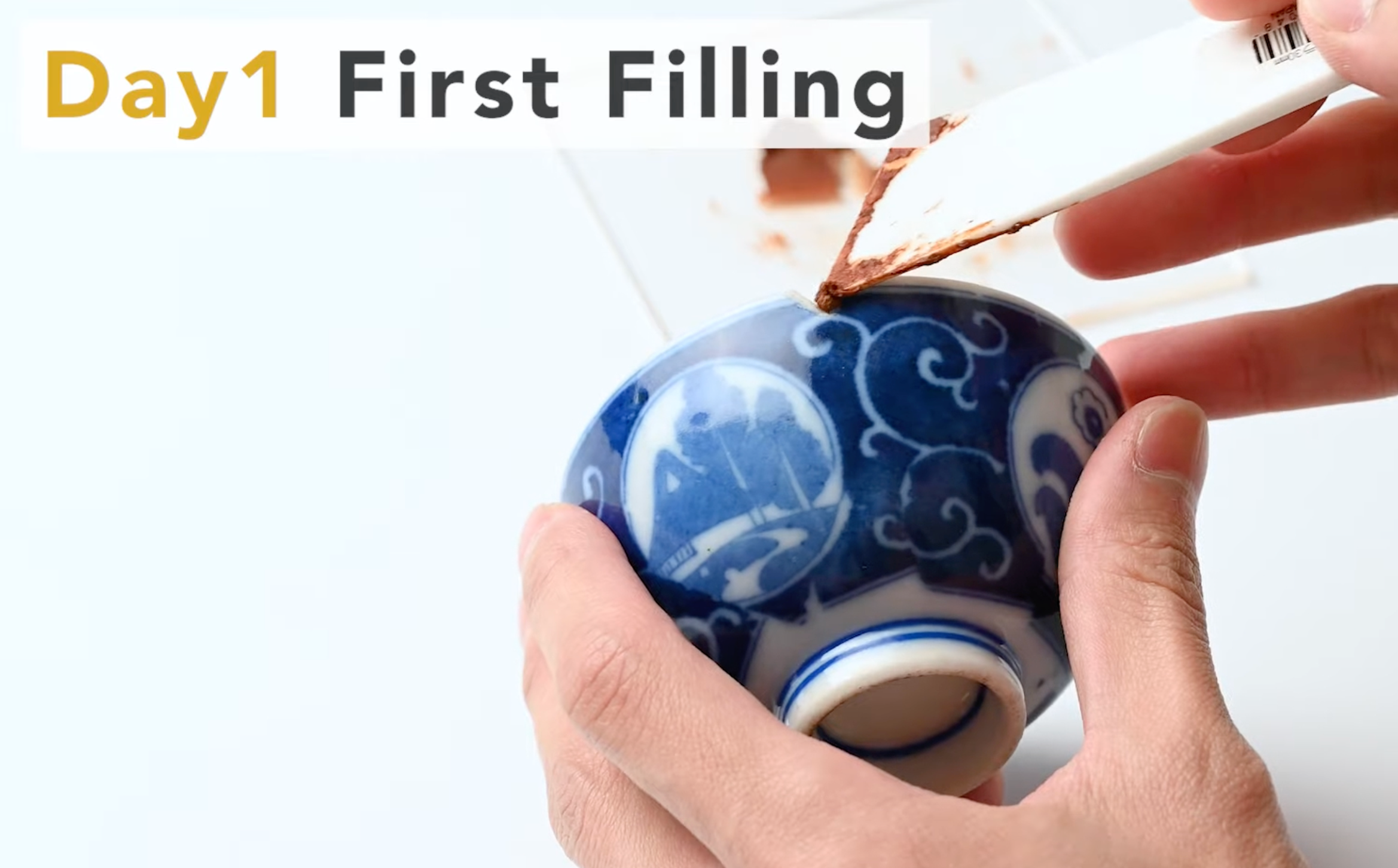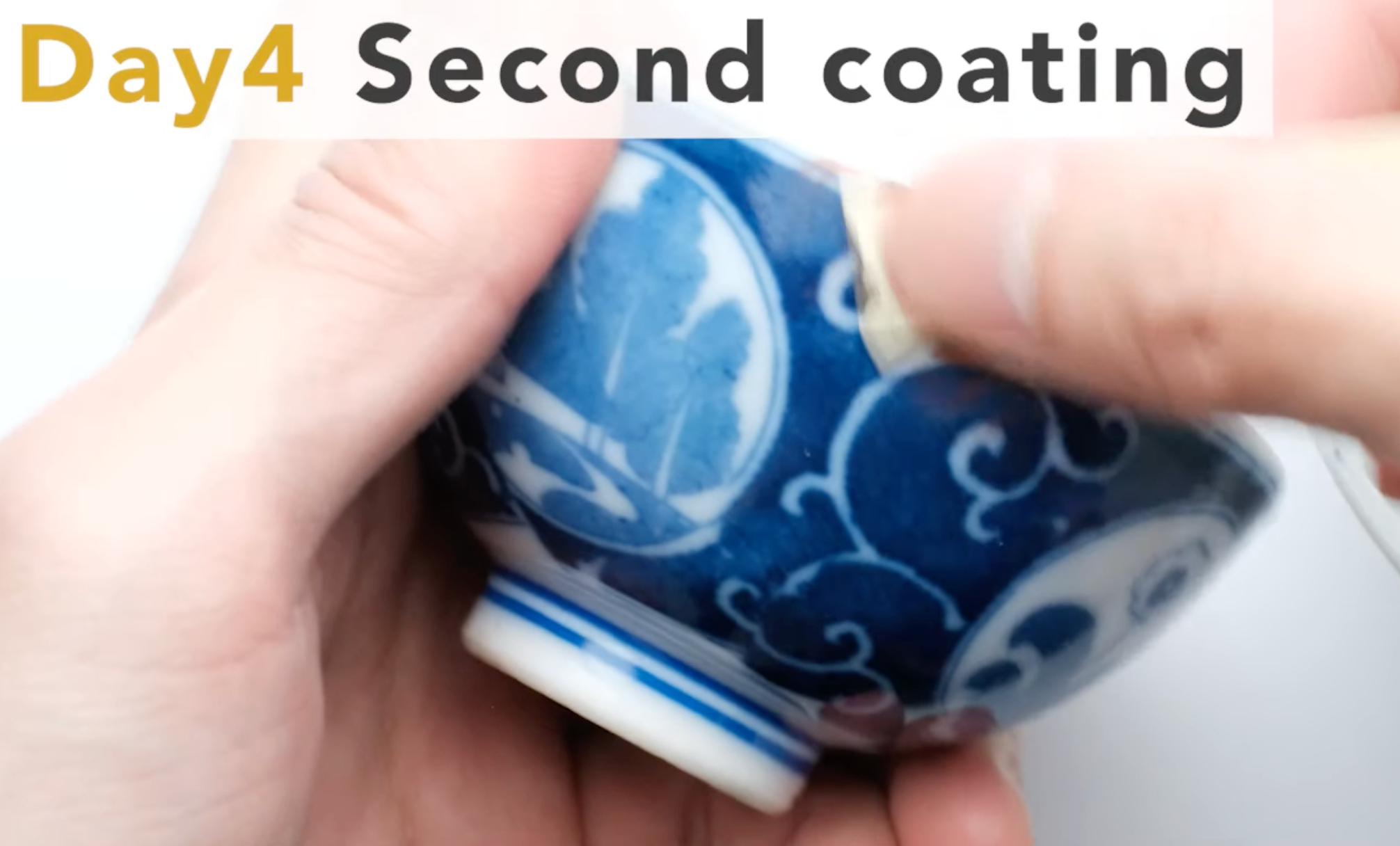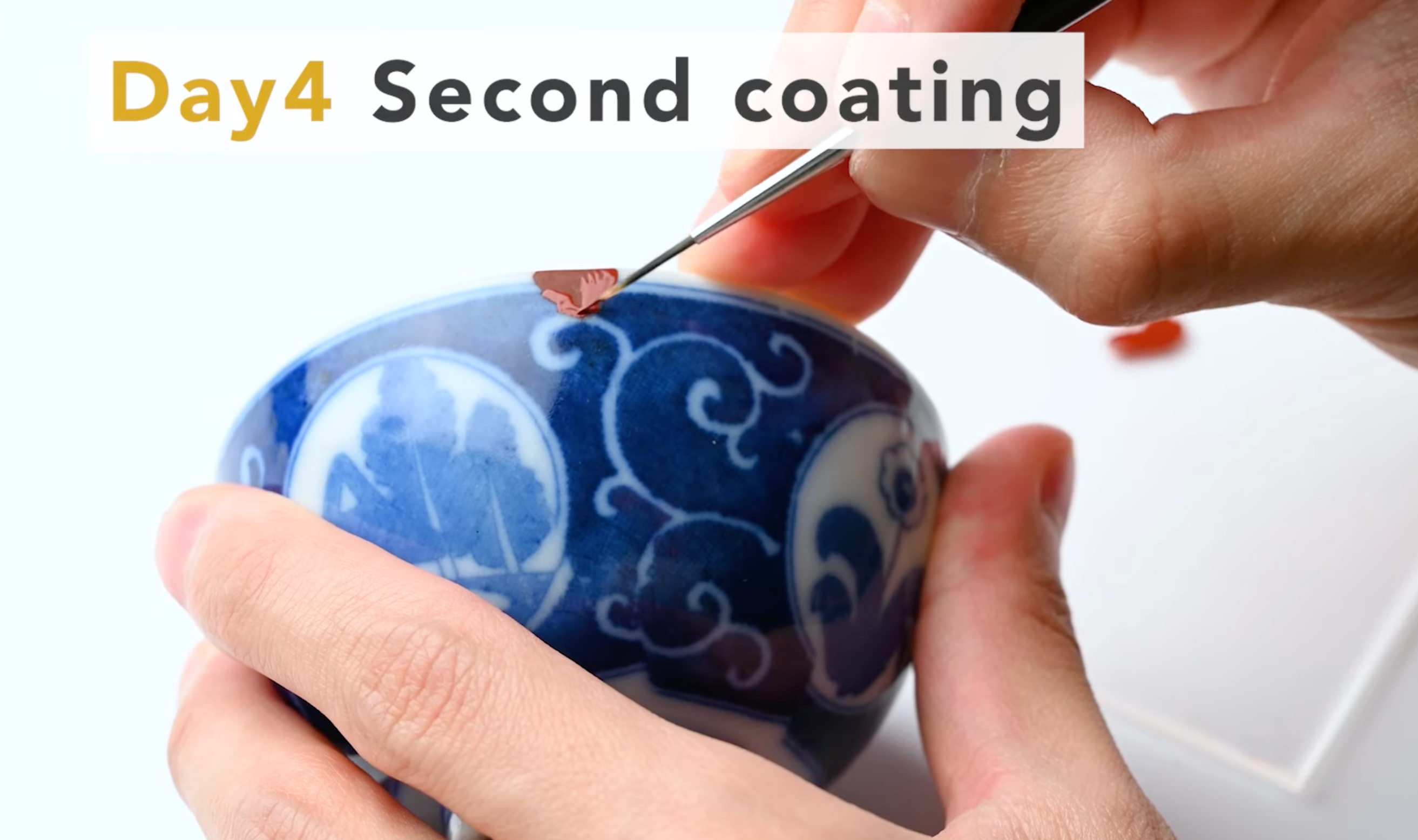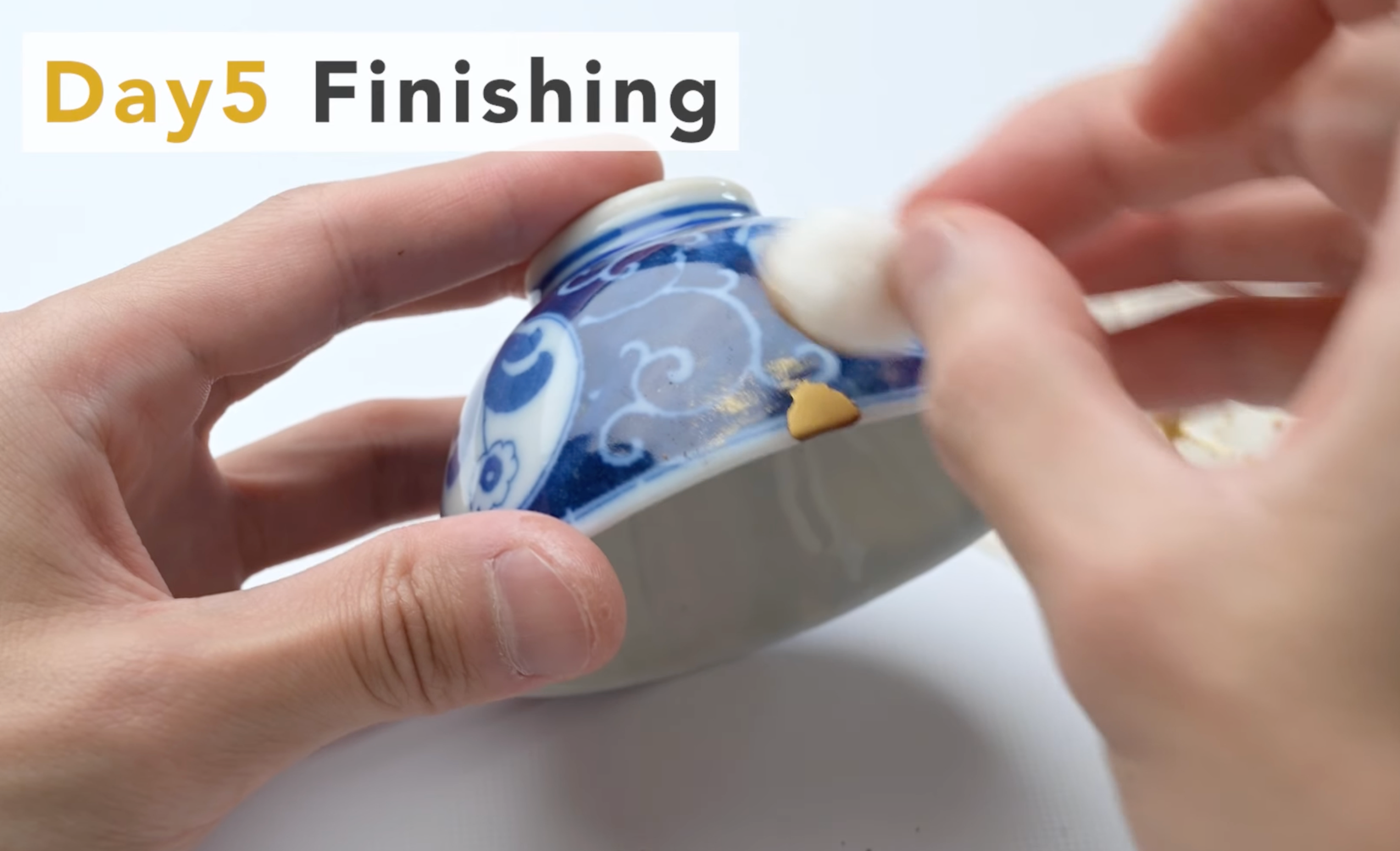Lesson 02: Chipped


1. Making "Kokuso-urushi"
In kintsugi, two types of putty are used for filling.
One is sabi urushi, which is used to fill small grooves or chips of less than 2 mm.
The other is kokuso urushi, which is used to fill chips of 2mm or more in depth.

In this case, we will use "Kokuso-urushi" to fill the chipped area.
- Ingredients for Kokuso-Urushi
- Cake flour: 1 grated spoonful
- Water: 1 grated spoonful
- Raw urushi: 2 grated spoonful
- Wood powder: 2 grated spoonful
- ※With 0.1ml measuring spoon
First, mix cake flour and water on an acrylic board and knead until the mixture resembles bread dough. If it does not resemble bread dough and is too watery, remake it again.
Then add raw urushi and knead well with a spatula.
When the surface becomes smooth and stretchy, add wood powder and knead well.
When the ingredients are well mixed, "Kokuso-urushi" is ready.

2. Put kokuso urushi on the chip
When the kokuso-urushi is ready, put it on the chip.
Thin glazed ceramics should have masking tape around them beforehand to prevent staining.
After a certain amount of kokuso-urushi has been placed on the surface, use your fingers to shape it into the shape of the ceramics.
At this stage, it is not necessary to completely match the shape of the pottery, but if the it is too thick, it will be difficult to harden.
Keep the thickness of the kokuso-urushi to the same level as that of the pottery.
When applying kokuso urushi, keep the thickness to about 2mm at a time.
This is because if it is applied too thickly, the core may not harden.
For chips deeper than 2 mm, repeat this step several times.

3. Wait about a week to harden
Wait a week for the kokuso-urushi to harden.
The kokuso-urushi does not need much humidity to harden, but it may not harden sufficiently in dry areas, for example.
To be safe, keep it in a place with a humidity of around 70% and a temperature of around 25 degrees Celsius.
- note
- One method is to place wet towels in cardboard boxes to maintain the right humidity for storage.
- The temperature should also be kept from getting cold by using air conditioning.
- In particular, urushi may not harden properly if the temperature falls below 20 degrees Celsius, so be careful to control both temperature and humidity after working on this and subsequent steps.

How to wash tools
Wipe off any tools with urushi using a tissue moistened with ethanol.
All tools except for the brush can be wiped off with ethanol.
1. Making "Kokuso-urushi"
In kintsugi, two types of putty are used for filling.
One is sabi urushi, which is used to fill small grooves or chips of less than 2 mm.
The other is kokuso urushi, which is used to fill chips of 2mm or more in depth.
In this case, we will use "Kokuso-urushi" to fill the chipped area.
- Ingredients for Kokuso-Urushi
- Cake flour: 1 grated spoonful
- Water: 1 grated spoonful
- Raw urushi: 2 grated spoonful
- Wood powder: 2 grated spoonful
- ※With 0.1ml measuring spoon
First, mix cake flour and water on an acrylic board and knead until the mixture resembles bread dough. If it does not resemble bread dough and is too watery, remake it again.
Then add raw urushi and knead well with a spatula.
When the surface becomes smooth and stretchy, add wood powder and knead well.
When the ingredients are well mixed, "Kokuso-urushi" is ready.
2. Put kokuso urushi on the chip
When the kokuso-urushi is ready, put it on the chip.
Thin glazed ceramics should have masking tape around them beforehand to prevent staining.
After a certain amount of kokuso-urushi has been placed on the surface, use your fingers to shape it into the shape of the ceramics.
At this stage, it is not necessary to completely match the shape of the pottery, but if the it is too thick, it will be difficult to harden.
Keep the thickness of the kokuso-urushi to the same level as that of the pottery.
When applying kokuso urushi, keep the thickness to about 2mm at a time.
This is because if it is applied too thickly, the core may not harden.
For chips deeper than 2 mm, repeat this step several times.
3. Wait about a week to harden
Wait a week for the kokuso-urushi to harden.
The kokuso-urushi does not need much humidity to harden, but it may not harden sufficiently in dry areas, for example.
To be safe, keep it in a place with a humidity of around 70% and a temperature of around 25 degrees Celsius.
- note
- One method is to place wet towels in cardboard boxes to maintain the right humidity for storage.
- The temperature should also be kept from getting cold by using air conditioning.
- In particular, urushi may not harden properly if the temperature falls below 20 degrees Celsius, so be careful to control both temperature and humidity after working on this and subsequent steps.
How to wash tools
Wipe off any tools with urushi using a tissue moistened with ethanol.
All tools except for the brush can be wiped off with ethanol.






1. Scrape off excess Kokuso-urushi
Once the kokuso-urushi is firmly hardened, scrape it off with a cutter.
Thin stains should be wiped up with ethanol.
Shave it as much as possible to get as close to the original ceramics shape as possible.
The lacks will be filled in the next step, so now let's shave off the excess and shape it.

2. Making "Sabi-urushi"
Once excess kokuso-urushi is removed, we will use "Sabi-urushi" to fill the remainging unfilled areas.
- Ingredients for sabi-urushi
- Tonoko: 2 grated spoonful
- Water: 1 grated spoonful
- Raw urushi: 1 grated spoonful
- ※With 0.1ml measuring spoon
First, take Tonoko on an acrylic plate, add water and mix them.
Then, add raw urushi and knead with a spatula.
Sabi-urushi dries quickly, so put it together so that the surface area is small.

3. Apply sabi-urushi to the chipped area
When the sabi-urushi is ready, apply a thin coat to the areas you have just shaved off.
If there are any dents or areas that have been cut off too much, fill them in this process.

4. Wait a few days for the sabi-urushi to harden
Applying sabi-urushi is complete when the surface is flat with no dents.
Wait a few days for it to harden firmly.
- Note
- If you try to fill large chips with sabi-urushi, only the surface of the sabi-urushi might dry, leaving the inside dull. If you want to fill in a thickness of more than 2~3mm, you should again use kokuso-urushi.
1. Scrape off excess Kokuso-urushi
Once the kokuso-urushi is firmly hardened, scrape it off with a cutter.
Thin stains should be wiped up with ethanol.
Shave it as much as possible to get as close to the original ceramics shape as possible.
The lacks will be filled in the next step, so now let's shave off the excess and shape it.
2. Making "Sabi-urushi"
Once excess kokuso-urushi is removed, we will use "Sabi-urushi" to fill the remainging unfilled areas.
- Ingredients for sabi-urushi
- Tonoko: 2 grated spoonful
- Water: 1 grated spoonful
- Raw urushi: 1 grated spoonful
- ※With 0.1ml measuring spoon
First, take Tonoko on an acrylic plate, add water and mix them.
Then, add raw urushi and knead with a spatula.
Sabi-urushi dries quickly, so put it together so that the surface area is small.
3. Apply sabi-urushi to the chipped area
When the sabi-urushi is ready, apply a thin coat to the areas you have just shaved off.
If there are any dents or areas that have been cut off too much, fill them in this process.
4. Wait a few days for the sabi-urushi to harden
Applying sabi-urushi is complete when the surface is flat with no dents.
Wait a few days for it to harden firmly.
- Note
- If you try to fill large chips with sabi-urushi, only the surface of the sabi-urushi might dry, leaving the inside dull. If you want to fill in a thickness of more than 2~3mm, you should again use kokuso-urushi.





1. Scrape off the sabi-urushi
After the sabi-urushi has hardened, scrape off it on the overhangs with a cutter to make the seams flat and even.
If the surface is large and difficult to smooth with a cutter, use a sandpaper to smooth the surface as much as possible.
Wipe off any dirt on the surface of the ceramics with an ethanol-soaked tissue as appropriate.

2. Coating with "Bengara urushi"
Once the shape is ready, the next step is to coating with bengara urushi.
Wipe the brush tip thoroughly with ethanol first before use.
It is recommended to apply the inside first because if you apply the outside first, you may touch the seam when applying the inside.
Work as if you were "filling in the gaps with urushi" rather than "applying urushi".
Apply so that the surface is this smooth.

3. Wait few days to harden
When you have finished coating, leave it in the humid room and wait for a few days.
Also, keep the temperature around 25°C and the humidity around 70% because it will not harden if the temperature and humidity is too low.
On the other hand, too high a humidity of 80% or more is not good, as it may cause wrinkles when the urushi hardens.
- note
- One method is to place wet towels in cardboard boxes to maintain the right humidity for storage.
- The temperature should also be kept from getting cold by using air conditioning.
- In particular, urushi may not harden properly if the temperature falls below 20 degrees Celsius, so be careful to control both temperature and humidity after working on this and subsequent steps.

How to wash brushes
Wash brushes after use with vegetable oil such as rapeseed oil.
Dip the brush into the oil that has been put out on the acrylic plate and wipe it off with a tissue.
Repeat this process until there is almost no color on the tissue.
Finally, put the cap on and store the brush with a little oil remaining on it.
Otherwise, the brush tip may harden.
Finally, completely wipe off any oil remaining on the acrylic plate with ethanol.
If even a small amount of oil is left, it may mix with the oil and prevent the urushi from hardening next time.
1. Scrape off the sabi-urushi
After the sabi-urushi has hardened, scrape off it on the overhangs with a cutter to make the seams flat and even.
If the surface is large and difficult to smooth with a cutter, use a sandpaper to smooth the surface as much as possible.
Wipe off any dirt on the surface of the ceramics with an ethanol-soaked tissue as appropriate.
2. Coating with "Bengara urushi"
Once the shape is ready, the next step is to coating with bengara urushi.
Wipe the brush tip thoroughly with ethanol first before use.
It is recommended to apply the inside first because if you apply the outside first, you may touch the seam when applying the inside.
Work as if you were "filling in the gaps with urushi" rather than "applying urushi".
Apply so that the surface is this smooth.
3. Wait few days to harden
When you have finished coating, leave it in the humid room and wait for a few days.
Also, keep the temperature around 25°C and the humidity around 70% because it will not harden if the temperature and humidity is too low.
On the other hand, too high a humidity of 80% or more is not good, as it may cause wrinkles when the urushi hardens.
- note
- One method is to place wet towels in cardboard boxes to maintain the right humidity for storage.
- The temperature should also be kept from getting cold by using air conditioning.
- In particular, urushi may not harden properly if the temperature falls below 20 degrees Celsius, so be careful to control both temperature and humidity after working on this and subsequent steps.
How to wash brushes
Wash brushes after use with vegetable oil such as rapeseed oil.
Dip the brush into the oil that has been put out on the acrylic plate and wipe it off with a tissue.
Repeat this process until there is almost no color on the tissue.
Finally, put the cap on and store the brush with a little oil remaining on it.
Otherwise, the brush tip may harden.
Finally, completely wipe off any oil remaining on the acrylic plate with ethanol.
If even a small amount of oil is left, it may mix with the oil and prevent the urushi from hardening next time.





1. Polish the chipped area with abrasive sheets
After the first coat of bengara urushi dries, polish the seams using soft abrasive sheets.
The polishing sheet is soft and fine-grained, so it will not scratch the glaze even if it is polished directly.
However, the gilding and painting may come off, so protect it with masking tape beforehand.
When the seams are flat enough that you can run your finger over them and not feel any bumps, wipe with ethanol.

2. Coating with bengara urushi
Once polished, in many cases grooves and wrinkles still remain.
In such cases, coat the surface again using the same procedure as step 4.
Wipe the brush tip thoroughly with ethanol first before use.
When you have finished coating, leave it in the humid and warm place and wait for a few days.
- Tips
- In this procedure, the coating process has been applied twice, but basically the coating process is repeated until the seams are flat. Conversely, if the work is finished beautifully at the point of the first coat, the 2nd coat may not be applied.

How to wash brushes
Wash brushes after use with vegetable oil such as rapeseed oil.
Dip the brush into the oil that has been put out on the acrylic plate and wipe it off with a tissue.
Repeat this process until there is almost no color on the tissue.
Finally, put the cap on and store the brush with a little oil remaining on it.
Otherwise, the brush tip may harden.
Finally, completely wipe off any oil remaining on the acrylic plate with ethanol.
If even a small amount of oil is left, it may mix with the oil and prevent the urushi from hardening next time.
1. Polish the chipped area with abrasive sheets
After the first coat of bengara urushi dries, polish the seams using soft abrasive sheets.
The polishing sheet is soft and fine-grained, so it will not scratch the glaze even if it is polished directly.
However, the gilding and painting may come off, so protect it with masking tape beforehand.
When the seams are flat enough that you can run your finger over them and not feel any bumps, wipe with ethanol.
2. Coating with bengara urushi
Once polished, in many cases grooves and wrinkles still remain.
In such cases, coat the surface again using the same procedure as step 4.
Wipe the brush tip thoroughly with ethanol first before use.
When you have finished coating, leave it in the humid and warm place and wait for a few days.
- Tips
- In this procedure, the coating process has been applied twice, but basically the coating process is repeated until the seams are flat. Conversely, if the work is finished beautifully at the point of the first coat, the 2nd coat may not be applied.
How to wash brushes
Wash brushes after use with vegetable oil such as rapeseed oil.
Dip the brush into the oil that has been put out on the acrylic plate and wipe it off with a tissue.
Repeat this process until there is almost no color on the tissue.
Finally, put the cap on and store the brush with a little oil remaining on it.
Otherwise, the brush tip may harden.
Finally, completely wipe off any oil remaining on the acrylic plate with ethanol.
If even a small amount of oil is left, it may mix with the oil and prevent the urushi from hardening next time.




1. Polish the chipped area with abrasive sheets.
After the 2nd coat of bengara urushi dries, polish the seams using an abrasive sheet.
The polishing sheet is soft and fine-grained, so it will not scratch the glaze even if it is polished directly.
However, the painting may come off, so protect it with masking tape beforehand.
When the seams are flat enough that you can run your finger over them and not feel any bumps, wipe the whole thing down with ethanol.

2. Apply a thin coat of Bengara-urushi
Once the seams are in place, it is time to prepare for applying gold powder.
First, a "thin" layer of bengara-urushi is applied to the seams.
Be careful not to apply it too thickly, otherwise the gold powder will sink into the bengara urushi.
- Tips for applying thin coat
- Put a little bengara urushi on the brush tip.
- Move the brush slowly.
- Do not add more bengara urushi until the bengara urushi becomes faint.
If you add bengara urushi to the tip frequently, it will be applied too thickly.

3. Apply gold powder
After applying bengara-urushi, apply gold powder.
First, put generous amount of gold powder on a cotton ball.
Then move the cotton ball in small circles over the seams.
- Tips
- Be careful that the cotton itself does not touch urushi.
- Ideally, only the gold powder on the cotton should touch the urushi.
- The key is to apply gently and with as little force as possible.
After the entire surface has been applied with gold powder, add more gold powder on the cotton ball, and move the cotton ball around the seams to apply it in a spaceless way.
This will give it more luster.

4. Wait few days to harden
When you have finished applying, leave it in the humid room and wait for a few days.
Also, keep the temperature around 25°C and the humidity around 70% because it will not harden if the temperature and humidity is too low.
On the other hand, too high a humidity of 80% or more is not good, as it may cause wrinkles when the urushi hardens.
- note
- One method is to place wet towels in cardboard boxes to maintain the right humidity for storage.
- The temperature should also be kept from getting cold by using air conditioning.
- In particular, urushi may not harden properly if the temperature falls below 20 degrees Celsius, so be careful to control both temperature and humidity after working on this and subsequent steps.

5. Completion
After one to two weeks in the urushi room, the bengara urushi hardens and the gold powder is fixed to the seams.
Wipe off the surface with a wet wipe to complete the process.
At this time, wipe with water, not ethanol.
Wiping with ethanol may remove even gold powder.
1. Polish the chipped area with abrasive sheets.
After the 2nd coat of bengara urushi dries, polish the seams using an abrasive sheet.
The polishing sheet is soft and fine-grained, so it will not scratch the glaze even if it is polished directly.
However, the painting may come off, so protect it with masking tape beforehand.
When the seams are flat enough that you can run your finger over them and not feel any bumps, wipe the whole thing down with ethanol.
2. Apply a thin coat of Bengara-urushi
Once the seams are in place, it is time to prepare for applying gold powder.
First, a "thin" layer of bengara-urushi is applied to the seams.
Be careful not to apply it too thickly, otherwise the gold powder will sink into the bengara urushi.
- Tips for applying thin coat
- Put a little bengara urushi on the brush tip.
- Move the brush slowly.
- Do not add more bengara urushi until the bengara urushi becomes faint.
If you add bengara urushi to the tip frequently, it will be applied too thickly.
3. Apply gold powder
After applying bengara-urushi, apply gold powder.
First, put generous amount of gold powder on a cotton ball.
Then move the cotton ball in small circles over the seams.
- Tips
- Be careful that the cotton itself does not touch urushi.
- Ideally, only the gold powder on the cotton should touch the urushi.
- The key is to apply gently and with as little force as possible.
After the entire surface has been applied with gold powder, add more gold powder on the cotton ball, and move the cotton ball around the seams to apply it in a spaceless way.
This will give it more luster.
4. Wait few days to harden
When you have finished applying, leave it in the humid room and wait for a few days.
Also, keep the temperature around 25°C and the humidity around 70% because it will not harden if the temperature and humidity is too low.
On the other hand, too high a humidity of 80% or more is not good, as it may cause wrinkles when the urushi hardens.
- note
- One method is to place wet towels in cardboard boxes to maintain the right humidity for storage.
- The temperature should also be kept from getting cold by using air conditioning.
- In particular, urushi may not harden properly if the temperature falls below 20 degrees Celsius, so be careful to control both temperature and humidity after working on this and subsequent steps.
5. Completion
After one to two weeks in the urushi room, the bengara urushi hardens and the gold powder is fixed to the seams.
Wipe off the surface with a wet wipe to complete the process.
At this time, wipe with water, not ethanol.
Wiping with ethanol may remove even gold powder.





Basic Kit
Lesson 02: Chipped



Leave a comment
All comments are moderated before being published.
This site is protected by hCaptcha and the hCaptcha Privacy Policy and Terms of Service apply.